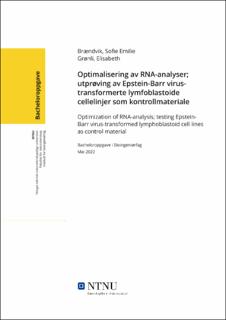| dc.contributor.advisor | Holien, Toril | |
| dc.contributor.advisor | Svaasand, Eva Kathrine | |
| dc.contributor.advisor | Sjursen, Wenche | |
| dc.contributor.author | Brændvik, Sofie Emilie | |
| dc.contributor.author | Grønli, Elisabeth | |
| dc.date.accessioned | 2022-06-22T17:19:18Z | |
| dc.date.available | 2022-06-22T17:19:18Z | |
| dc.date.issued | 2022 | |
| dc.identifier | no.ntnu:inspera:106147449:107341411 | |
| dc.identifier.uri | https://hdl.handle.net/11250/3000110 | |
| dc.description.abstract | Avdeling for medisinsk genetikk (AMG) på St. Olavs Hospital har behov for nytt kontrollmateriale til analyser av RNA. Gentesting kan utføres på RNA-nivå som et supplement til gentesting på DNA-nivå. Dette utføres som regel ved sekvensering av cDNA, og det er nødvendig med en normal kontroll som behandles på lik måte som pasientprøvene. Årsaken er at kontrollen skal kunne brukes som en referanse for pasientprøver. En referansesekvens er viktig fordi messenger-RNA (mRNA) kan settes sammen på ulike måter ved alternativ spleising og danne ulike transkripter. Dette kan forstyrre analyseringen ved at transkriptene danner en bakgrunnssekvens som kan forveksles med patogene varianter.
Denne oppgaven tar for seg en uttesting av humane lymfoblastoide B-cellelinjer fra Coriell Institutt i USA, for å finne ut om de kan brukes som normal kontroll. I forkant av bachelorprosjektet ble cellelinjene dyrket ved Institutt for Klinisk og molekylær medisin. Videre ble lymfocyttene dyrket i korttidskultur av ansatte ved AMG. RNA ble isolert fra lymfocyttene og cDNA-syntese ble utført. Vår oppgave har vært å amplifisere cDNA ved bruk av PCR og deretter sangersekvensere produktet for å identifisere baserekkefølgen. Sekvensene til cellelinjene har blitt sammenlignet med sekvensene til normale pasientprøver. Gelelektroforese ble utført som et kontrolltrinn underveis for å sikre at nok cDNA ble amplifisert ved PCR.
Resultatene viser at cellelinjene oppfører seg som normale pasientprøver ved at de viser de samme transkriptene og benigne variantene. Det er grunn til å tro at konsentrasjonen av RNA ikke har betydning for signalstyrke og kvalitet på sekvensene, men at RIN-verdi er mer avgjørende. Resultatene er basert på analyser av genene NF1 og PTCH1, og de gir grunnlag for å gå videre med analysering av flere aktuelle gener. Videre må avdelingen validere cellelinjene for å kunne ta de i bruk som kontrollmateriale. | |
| dc.description.abstract | The department of medical genetics (AMG) at St. Olavs Hospital need a new control for their analyzes on RNA. RNA-analysis is a form of genetic testing used as a supplement for analysis on DNA. Genetic testing is usually performed by sequencing cDNA, and it is crucial to have a control material that follows the samples through the whole process of analysis. The control must also have the ability to work as a reference sequence for normal samples to be compared with. It is important to have a reference sequence during these analyzes, because messenger-RNA (mRNA) can bind exons differently and end up in different transcripts through alternative splicing. This can disturb the analyzing process by creating a background-sequence that can be mistaken for a pathogenic variant.
This thesis argues if lymphoblastoid B-cell lines from Coriell Institute in the USA can be used as a normal control for analysing RNA. Prior to this bachelor project, the Institute of clinical and molecular medicine (IKOM) at NTNU have cultivated cells from the cell lines. Furthermore, the B-lymphocytes were cultivated in a short-term cell culture by employees at AMG. RNA was isolated from the cells and cDNA-synthesis was performed. Our assignment was to amplify cDNA during PCR, following sanger sequencing to identify the order of the nucleotides in the sequence. The sequence from the cell lines was compared to the sequence from normal patient samples. Gel electrophoresis was executed as a step for ensuring that enough cDNA was amplified from the PCR-reaction.
The results shows that the cell lines behave the same way as normal patient samples because they all show the same transcripts and benign variants in the genes we tested. There is reason to believe that the concentration of RNA does not affect the strength of the signal nor the quality of the sequences, but that the RIN-score is more decisive. The results we got from analysing on NF1 and PTCH1 gives reason to conduct the same tests on several other complex genes as well. Now the department must validate the cell lines before they can be incorporated as control for the routine work at the department. | |
| dc.language | nob | |
| dc.publisher | NTNU | |
| dc.title | Optimalisering av RNA-analyser; utprøving av Epstein-Barr virus-transformerte lymfoblastoide cellelinjer som kontrollmateriale | |
| dc.type | Bachelor thesis | |
